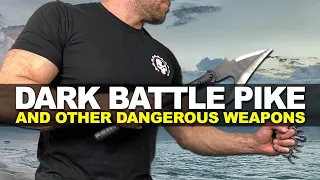Best Non-Lethal Self Defense Weapons You Can Trust
October 20th, 2025
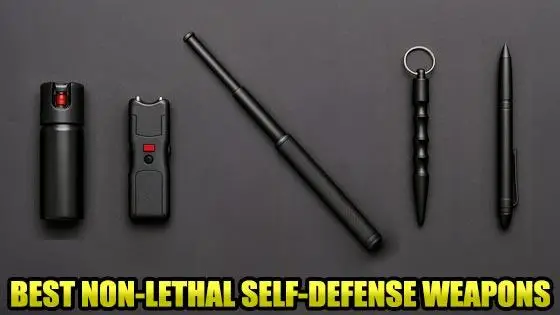
When it comes to personal protection, the best weapon is one you can actually carry, access quickly, and use with confidence. Non-lethal self defense weapons give you that balance of safety and practicality by providing tools designed to stop a threat without causing permanent harm. Whether you're walking to your car after dark, traveling to unfamiliar places, or just wanting a little extra peace of mind, understanding your options is the first step to staying prepared. In this guide, we'll break down the most reliable non-lethal self defense tools, how they work, and how to choose one that fits your lifestyle.
What Counts as a Non-Lethal Weapon?
A non-lethal weapon is any tool designed to stop, slow down, or distract an attacker without aiming to cause permanent injury or death. The goal is simple: create an immediate opportunity to escape and get to safety. That makes non-lethal options ideal for everyday carry because they let you respond to a threat without escalating to lethal force.
Non-lethal tools fall into a few practical categories. Chemical devices like pepper spray irritate the eyes and respiratory system so an assailant is temporarily blinded and disoriented. Electronic devices deliver a high-voltage shock that interrupts muscle control for a short time. Impact tools such as collapsible batons provide reach and stopping power through blunt force. Everyday carry tools like tactical pens and Kubotans are low profile items that can be used for close-range control. Finally, attention tools like personal alarms use sound to attract help and deter attackers.
Mechanism matters more than the label. Chemical sprays create distance; electronic devices disrupt movement; impact tools rely on leverage and reach; everyday carry items depend on technique. Each type has trade offs in range, ease of use, legal exposure, and training needs. For most people, the best choice is a tool that matches their comfort, routine, and the environments they frequent.
You will also see the term non-lethal paired with phrases like less-lethal or directed-energy device in some writing. Those are just variations on the same idea: reduce the chance of fatal outcomes while providing an effective defensive option. In practical terms, pick a category that fits how you live, then learn how to carry, access, and use that tool reliably so it helps you when seconds matter.
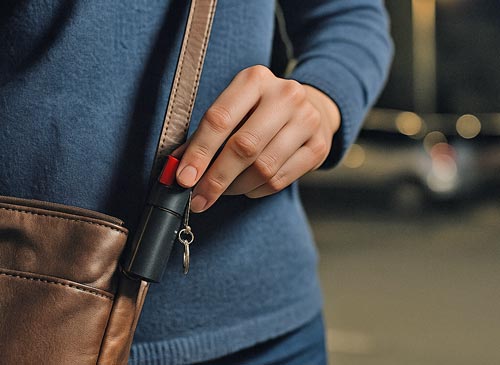
Pepper Spray: Fast, Portable, and Trusted
Pepper spray is the go-to option for many people because it is simple to use, lightweight, and effective at creating distance between you and a threat. It works by releasing a concentrated capsaicin spray that causes immediate burning in the eyes, coughing, and temporary breathing difficulty. Those effects give you a short window to move away and get help.
Use cases are clear. For nightly walks, late runs, rides to a parked car, or crowded transit stops, a pepper spray canister is practical and quick to deploy. Look for a canister with a safety lock, a clear nozzle, and at least a four to six foot effective range so you can deploy it before someone gets too close. Compact keychain models are convenient, while slightly larger canisters offer more range and a steadier spray.
Training tips matter. Practice the draw from the place you will actually carry it until the motion is automatic. When you deploy, aim for the eyes and spray in short bursts while moving laterally away from the threat. After use, get to safety and seek fresh air. If you or a companion are exposed, flush eyes with clean water and seek medical attention if symptoms persist.
Be aware of limitations. Wind can blow spray back toward you in outdoor settings, and enclosed spaces can reduce its effectiveness. Also check the expiration date and replace old canisters. Store pepper spray where it is easy to reach but out of reach of children. When traveling, verify whether pepper spray is allowed in your destination and never attempt to bring it on board aircraft.
For product selection, prioritize reliable brands and clear labeling. If you want to explore options, check out our pepper spray category for related tools and bundles.
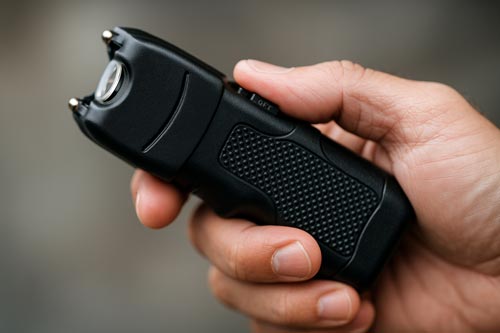
Electronic Stun Devices
Electronic stun devices deliver a high-voltage, low-amperage pulse to interrupt muscle control and create a brief window for escape. They are designed to temporarily disrupt an attacker's ability to move so you can create distance and get to safety. Some models require direct contact to work, while others deploy short-range probes to reach a target from a small distance away.
The main advantages are speed and reliability. When used correctly, a stun device can stop an assailant instantly without relying on chemical effects or aim. They are reusable and work in a variety of conditions, including cooler weather or light clothing. Many users find the audible crackle and visible spark to be both a deterrent and a practical indicator that the device is functioning.
Limitations are important to understand. Electronic devices require close proximity in many cases, so you must allow someone into arm's reach before you can deploy them effectively. Battery life, probe placement, and the target's physical condition affect performance. Regularly test and charge battery-powered devices and practice the activation motion so it becomes automatic under stress.
Legal rules for stun devices vary by state and locality, with some areas restricting possession or sale of higher-voltage units. Check local laws before purchasing or carrying one, and be careful with transport across state lines or on commercial flights. Training helps with safe handling, reducing accidental activation and improving deployment speed. Focus on safe draw practice, securing the device with a holster or pocket that prevents accidental discharge, and pairing the device with a clear escape plan.
When shopping, look for a compact model with an easy-to-use safety switch, clear activation feedback, and solid battery life. If you want to browse options, see our stun guns category for a selection of tested devices.
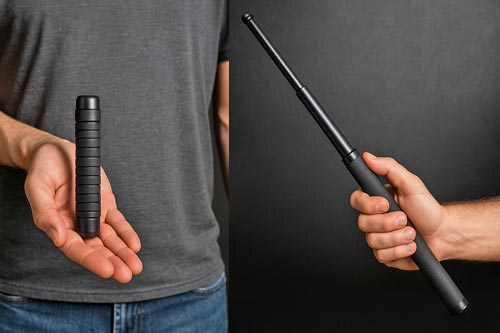
Collapsible Batons and Impact Tools
Collapsible batons and other impact tools give you reach and clear mechanical advantage when you need more stopping power than a small spray or pen can provide. A compact baton fits in a holster or bag and extends with a flick to full length, letting you keep distance while applying controlled strikes to slow or stop an aggressor. For many people, the combination of reach and solidity is what makes a baton feel like a reliable backstop in a bad situation.
These tools are best for people who commit to training. Proper technique includes the draw from your carry method, a safe extension motion, basic blocks, and well-placed strikes that prioritize disabling and escape rather than escalation. Repetition with a training baton teaches smooth extension and retraction, reduces fumbling under stress, and builds the confidence to use the tool only when necessary. Controlled practice also reduces the risk of injuring yourself or bystanders during deployment.
Be mindful of legal limits. Many states and localities restrict batons or treat them differently than simple everyday carry tools. Even where they are legal, restrictions often apply in schools, government buildings, and on transit. Always check up-to-date local laws before buying, carrying, or traveling with an impact tool. Transport rules can change when crossing state lines, so plan accordingly.
When selecting a baton, prioritize a solid locking mechanism, secure grip texture, and a length that fits how you plan to carry it. Common carry options include a belt holster, a dedicated bag compartment, or secure placement in a vehicle. If you plan to use a baton for personal protection, pair it with structured training that covers safe use, legal considerations, and rapid escape tactics.
For product comparisons and carry solutions, see the batons category where you can compare materials, lengths, and holster options.
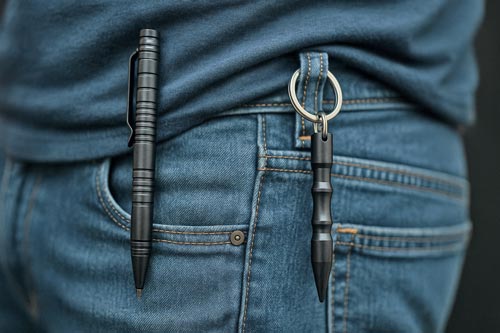
Tactical Pens and Kubotans
Tactical pens and Kubotans are two of the most practical everyday carry tools because they look ordinary while offering real defensive utility. A tactical pen functions as a writing instrument and a reinforced striking tool. A Kubotan is a short, rigid stick you can attach to a key ring for instant access. Both items rely on simple leverage, pressure, and targeting rather than brute strength, which makes them well suited for people of any size.
How they work is straightforward. Use a tactical pen to deliver short, controlled strikes to vulnerable targets or to apply painful pressure to escape a wrist or grab. A Kubotan is useful for joint locks, control holds, and quick strikes to sensitive areas. Because these tools are small and discreet, they are easy to carry on a keychain, clipped to a pocket, or kept in a purse without drawing attention.
The training curve is short but important. Practice basic drills that focus on draw mechanics, improving grip, and hitting simple target zones like the forearm, shin, or collarbone area with controlled force. Work on escape techniques that combine a short strike with an immediate move to create distance. Repetition makes the motions instinctive so you can act fast under stress.
Legal exposure is usually lower for pens and Kubotans compared with impact tools, but rules vary. Some jurisdictions treat them as everyday items, while others may classify them as offensive tools depending on intent. Carry them responsibly and be prepared to explain that they are for personal protection if questioned by authorities.
When choosing a model, look for solid, machined construction, a reliable clip or attachment point, and an ergonomic grip that fits your hand. A tactical pen with a removable cap or an integrated pocket clip speeds deployment. For Kubotans, choose a shape that gives you secure control and a durable attachment ring for keys.
If you want to compare options and specifications, check the Kubotans category to find styles that match your carry habits and training goals.
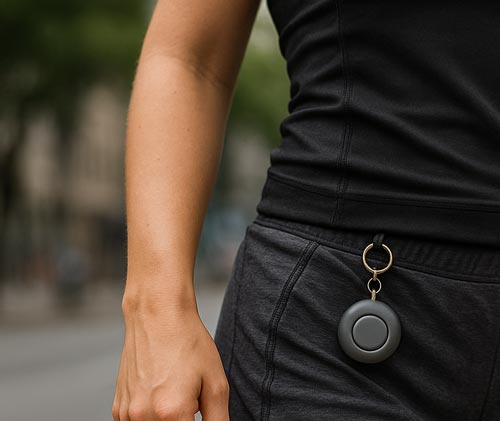
Personal Alarms and Smart Safety Devices
Personal alarms and smart safety devices are excellent options for people who prefer to avoid physical confrontation. These tools work by creating attention. A loud alarm, flashing light, or an automatic alert sent to trusted contacts can stop many threats by drawing witnesses and prompting help. Smart devices add conveniences such as GPS location sharing, two-way voice, and integration with a phone app so you can call for help even if you cannot speak.
Use cases are straightforward. A small keychain alarm is perfect for runners, students, and commuters because it is lightweight and easy to activate. For parents or solo travelers, a smart wearable or phone-connected device can automatically send your location to preselected contacts when an alarm is triggered. Businesses and night-shift workers also find these tools valuable because they alert others quickly without requiring physical force.
Practical tips make a big difference. Choose an alarm with at least 110 decibels so it will carry in populated areas, and test the activation method to make sure you can trigger it under stress. For smart devices, check battery life and whether the device relies on your phone's data connection or has its own cellular plan. Review the app permissions and how location sharing works so you know exactly what gets sent and to whom.
Pairing a personal alarm with a simple physical tool often works best. For example, carrying a keychain alarm alongside a compact pepper spray gives you both an attention-grabbing option and an active stopping tool. If you use a wearable or app, practice activating it while walking or in a parked car so the motion is second nature.
Legal and Safety Considerations
Understanding the legal side of carrying self defense weapons is just as important as choosing the right tool. Every state, and often individual cities within those states, has its own rules about what is allowed, where it can be carried, and how it can be used. A device that is perfectly legal in one place might be restricted or even banned in another. For example, certain areas limit the strength of pepper spray, while others prohibit electronic stun devices or impact weapons altogether.
Before purchasing or carrying any non-lethal weapon, take a few minutes to read the local laws on your state or city government website. Look specifically for terms like "personal protection devices," "impact weapons," or "electronic control devices." It is always better to confirm legality beforehand than to face a fine or confiscation later. If you plan to travel, remember that rules can change across state lines and become even stricter when crossing national borders.
Safety goes beyond legality. Responsible ownership means understanding how to use your tool correctly and when its use is justified. Using a weapon in self defense is typically allowed only if you reasonably believe you are in imminent danger. Misuse, accidental discharge, or use in non-threatening situations can result in criminal charges or civil penalties. For this reason, consider taking a short self defense course that includes both practical use and legal education.
Storage and transportation are equally important. Keep your self defense devices in places that are secure yet accessible to you in an emergency. Avoid leaving them in extreme heat or cold, which can damage electronics or pressurized canisters. Recharge or replace batteries on a regular schedule and check expiration dates on sprays. A weapon that does not work when you need it most can be more dangerous than having none at all.
When in doubt, seek clarification directly from your local police department or attorney general's office. Laws and interpretations can change quickly, so it is worth verifying every year or two. A responsible approach to ownership not only keeps you safe but also protects your right to carry effective non-lethal tools for personal defense.
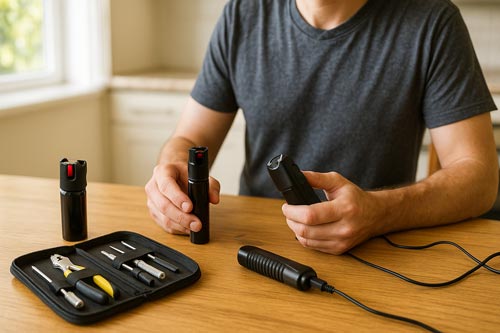
Training and Maintenance Tips
Owning a self defense weapon is only the first step. Knowing how to use it under pressure is what truly makes it effective. Even a few minutes of practice can make the difference between fumbling and responding with confidence. Start with simple drills that focus on drawing your tool from where you actually carry it (whether that's a purse, pocket, or belt clip) and activating it safely and quickly. Repetition builds muscle memory, and muscle memory keeps you calm when adrenaline is high.
Training does not have to be complicated. Many community centers and martial arts schools offer short courses on defensive awareness and non-lethal weapon handling. These classes usually cover distance control, target areas, and situational awareness. If you cannot find a class nearby, practice at home with an inert trainer version of your chosen tool, such as a water-filled spray or a deactivated stun device. The goal is to make safe, controlled handling second nature.
Maintenance is just as important as training. Check your devices regularly to ensure they work properly when you need them. For pepper spray, verify the expiration date and replace it every two to three years or sooner if it shows damage. For stun devices, charge them monthly and test the arc briefly to confirm the battery is strong. Inspect batons for secure locks and tight joints, and make sure tactical pens or Kubotans have no sharp burrs or loose fittings that could cause injury during use.
Storage matters too. Keep your tools accessible to you but out of the reach of children. Avoid leaving them in vehicles for long periods, as heat or cold can damage materials and reduce reliability. For battery-powered items, store them with partial charge and refresh them periodically to extend lifespan. Treat your personal protection gear the same way you would treat emergency equipment; inspect, test, and replace on a schedule.
Finally, remember that awareness and prevention are your best defenses. The safest outcome is always the one where you never have to use your weapon at all. Regular training, routine maintenance, and a calm, alert mindset turn your self defense tool into an extension of your awareness, not a substitute for it.
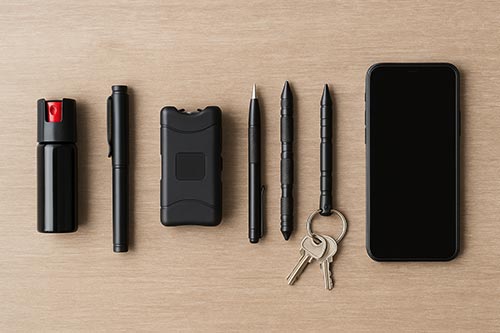
Choosing the Right Non-Lethal Weapon for You
The best self defense weapon is the one that fits your routine and comfort level. Start by thinking about where you spend most of your time and what situations make you feel vulnerable. Someone who walks to their car late at night might prefer pepper spray for quick deployment, while a jogger may benefit from a personal alarm clipped to their waistband. If you often carry a bag or drive for work, a compact baton or stun device might fit better into your setup.
Match your tool to your environment and habits. For example, if you work in an office or attend classes where strict rules apply, a low-profile tactical pen or Kubotan can give you discreet protection. If you live in an area with more lenient carry laws, a collapsible baton might be a good upgrade once you are comfortable with training. Avoid buying tools that feel intimidating or complicated-you will never use them confidently under stress.
It also helps to think in layers. Many people carry more than one non-lethal weapon to handle different situations. A pepper spray for distance, a stun device for close quarters, and a personal alarm for drawing attention make a versatile combination that covers multiple threat scenarios. Just remember that every tool requires practice, maintenance, and awareness to be effective.
No matter which route you choose, stay proactive about safety. The goal is not to prepare for violence but to move through the world with more confidence and peace of mind. If you are ready to explore tools that fit your needs, check out our complete selection of self defense weapons for tested, reliable, and legal options you can trust.
You May Also Be Interested In:
- Everyday Carry for Self Defense: Practical Tools You Can Trust
- Bushcraft vs Survival Knives: Which Blade Would You Trust in the Wild?
- Modern Viking Axe and Other Lethal Weapons
- Unleash Your Inner Ninja: 4 Lethal Weapons You Need to See
- Tactical Nightstick and Other Lethal Weapons!
- New Ninja Gear And Other Lethal Weapons
- Combat War Hammer and Other Lethal Weapons!
- Solid Metal Tonfa and Other Lethal Weapons!
- Urban Combat Kama and Other Lethal Weapons!
- Stealth Tactical Kama and Other Lethal Weapons!
Leave a Reply





